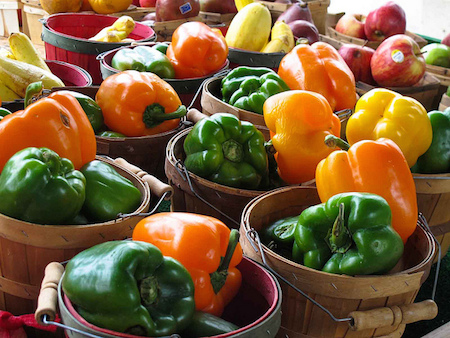There are two secrets to eating well—time and availability.
Money, especially an excess of it, can surprisingly get in the way of truly enjoying wholesome and nutritious food.
Fast food doesn’t necessarily equal cheap food.
Convenient food is the product of a society that values feeding a workforce as quickly as possible in order to maximize productivity. This extends from the highest paid professionals to the lowest paid minimum wage earners. Food may be packaged as healthful, e.g. organic, vegan, or gluten free, but this is only fast food in disguise.
The ingredients might be nutritious and environmentally sound but our relationship to the food itself is severed when we scarf something out of a package. Convenience food lacks real soul.
Be aware that the righteous satisfaction of tossing a “conscious food item” into your shopping cart is short lived. The fulfilment of slow food lasts longer and is more deeply satisfying.
For most of my life I have embraced the philosophies of simple living. The imagined domestic rhythms of the life of my great grandparents cast a romantic spell over me. If this life was truly satisfying to great grandma, I can’t really know. It is too late for me to ask her.
Regardless, this is a lifestyle that I pursued for decades in the United States but found to be elusive. Living in the Caribbean on a boat with an extremely limited income has been my answer to the whole food riddle. On boats, the majority of people live simply, so simple living becomes easy. It is normal.
When my family’s boat arrives in a new island port, the first thing I do is food shop like a local. How do I shop like a local? Instead of making a convenient but expensive stop at one of the modern supermarkets that are used mainly by wealthy foreigners, I buy meat from a butcher, fish from a fish monger, and fruits and veggies from backyard farmers or street markets.
Everyone grows their own produce on islands such as Grenada. Eggs are gathered from the bush and sold loose. Grains and legumes are sold from big sacks without any fanfare. Bulk foods are the rule not a hard-to-find specialty item from health food stores.
To buy meat, you point to a section of an animal hanging from a hook in a big, open, white-tiled room with drains in the floor—pig, cow, sheep, goat. This might seem grim to some of you but this is the reality of it. Where your food comes from is not hidden from you in “less developed” countries. A steak in a Caribbean supermarket costs US$9 per pound. A fresher steak from a local butchers costs US$2.50 per pound. The difference in price for fish is the same. Produce is a quarter of the cost if bought from the local growers. Spices are pennies in the outdoor markets. A pound of ground cinnamon costs as little as US$5 on some Caribbean islands.
Because everything is whole and unpackaged, I have noticed that I generate about one quarter of the garbage that I produced in the United States.
Now that I have simplified from necessity, I work from traditional recipes and techniques such as caramelizing sugar to a dark brown syrup and adding it to stews to give it a deep, sweet flavor. You will find my clothes dusted with flour from kneading the dough of the bread baking in the oven. My countertops are strewn with onion skins, carrot tops, and all manner of organic debris. Surveying my kitchen galley scene with satisfaction, I notice a difference. What is missing? Plastics bags, cardboard, styrofoam, cans and jars—namely packaging.
As the price of food goes down, the amount of time it takes to buy it goes up. Since I am now self employed, location independent, and rent free this is not problem for me. I love haggling with vendors and hunting down an elusive ingredient for a recipe. It’s pure joy being immersed in the jostling colorful market scene. Over the course of a morning, I can fill the big canvas sack slung over my shoulder with ginger, fresh tuna, bananas, mandarins, curries, paw paw, spring onions, limes, thyme, garden tomatoes, beans, yams, pumpkin, lettuce with clumps of dirt still clinging to the roots, and typically some new fruit or vegetable that I’ve never tried before.
In addition to the time it takes to buy the food, it takes considerably more time to prepare whole foods. The time difference between taking a slice of bread out of a bag and making a fresh loaf is hours. If you grind the grain yourself, add more hours. Same goes for a can of soup compared to a stew made from scratch. If I had a full time job, there is no way I could take five, six, or more hours a day to buy and prepare food for my family.
This is the trade off. Convenience food exists for practical reasons. People participating in the daily routines of a society based on capitalism and consumerism simply cannot live like our ancestors did a century ago. They don’t have the time. This is not new news.
However, the fact that you don’t have to spend all of your time wage earning in order to buy convenience items might be very new news to you indeed. It could be revolutionary news.
When I was last in the United States, things seemed backward and insane. To buy directly from a small local farmer was considered a luxury and was therefore much more expensive than buying over-processed and over-packaged goods from a superstore or chain restaurant.
Now that I have learned these pre-modern domestic skills from a pre-modern culture, I have to ask myself: will these skills work in America? When I return to the United States, will I be able to buy directly from producers for a much lower cost? Will I be able to create an economic bubble outside of the mainstream? We will see.
Comments welcomed.
Love elephant and want to go steady?
Sign up for our (curated) daily and weekly newsletters!
Editorial Apprentice: Jamie Khoo/Editor: Renée Picard
Photo: Steven Depolo/Flickr Creative Commons











Read 2 comments and reply